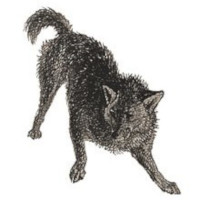 |
Perro Yagán |
|
He is not recognized by the F.C.I. |
Origin |
Chile | |
Translation |
Francis Vandersteen |
| The Perro Yagán or Perro Fueguino, also known as the Yaghan dog, is an extinct domesticated fox. It was a domestic form of the culpeo (Lycalopex culpaeus), unlike other domestic canids, domestic dogs, the domesticated gray wolf (Canis lupus), and the domestic red fox, the red fox (Vulpes vulpes). Very few specimens of the Perro Yagán remain. These include one in the Museo Salesiano Maggiorino Borgatello in Chile, and another in the Fagnano regional museum in Tierra del Fuego. Fuegian dogs had erect ears, pointed muzzles and thick tails. They were either fawn-colored or entirely white. Surviving images show them to be similar in size to the wild culpeo, which weighs from 5 to 13.5 kg, about the size of a Shetland sheepdog. Gauchos have called Fuegian dogs "handled dogs" because of their resemblance to the handled wolf. Lucas Bridges described the Romanian dog as "a sharp cross between an Alsatian police dog and a wolf". Captain Martial, who led the 1883 scientific expedition to Cape Horn, described the dog as "ugly, with long tawny hair and a pointed muzzle, it looks rather like a fox". Although the distribution of the Fuegian dog corresponds to that of the Yaghan people, the individual animals were not loyal to their human owners. Julius Popper emphasized the canid's lack of loyalty: "I have never seen them, however numerous, adopt an aggressive attitude or defend their masters when they were in danger". Fuegian dogs were not used to hunt guanaco. However, they could have been useful for hunting otters. Dogs were also useful to humans in that they gathered around their owners to keep them warm. Julius Popper noted: "The dogs clustered around the little Onas, taking the form of a kind of wrapper, I feel that the Fuegian dogs serve only to supplement the Indian's defective clothing, or better, as Ona's heated furniture". In 1919, when Silesian missionary Martin Gusinde visited the Yaghans, he noticed that their dogs had disappeared. Fuegian dogs had been exterminated because "they were dangerous to man and livestock". Their ferocious nature was also noted by Thomas Bridges in the 1880s, who wrote that they had attacked the goats on his mission. |






 English (United Kingdom)
English (United Kingdom)